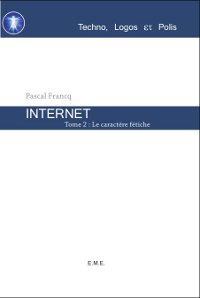Internet
1 Context
The increasing use of Internet in our privacy and at work lulls us in
the illusion that we understand the key elements and issues. Wrongly perceived as a homogeneous whole,
Internet is actually a set of disparate components and hosts a variety of stakeholders with interests
often different, sometimes contradictory.
The first volume tries to put the Internet in historical perspective by showing
how, from the creation of the network in the 1960s, we are now witnessing the emergence
of a collaborative production of content and of new forms of democracy, made
possible by the invention of the Web and the creation of online social networks. Beyond a description of the
major innovations, it recalls the technological assumptions, values and hopes
that guided the work of those who participated to the successive transformations of the Internet. The reader will also find the necessary conceptual and theoretical tools for a better understanding of the
dynamic and the existing practices on the Net.
The second volume aims to deconstruct the Internet object to identify the main
limits of its three components (the infrastructures, the contents and the tools that manage these contents), and to
understand the potential dangers. This deconstruction is the only way to achieve a good
understanding of the Internet and its potentials. Such a study going on by a description of the economical,
political and legal constraints which, beyond the technological ones, influence the evolution of the Internet. The reader
will discover some thoughts about the possible evolutions of the Internet and its ability to meet the
major challenges it faces today.
This book is actually only available in French.
2 Internet. Tome I: La construction d’un mythe

This volume can be ordered from the publisher's Web
site: EME Intercommunications.
A click on a chapter title shows its sections, but
a complete table of contents is also available.
- Prologue : Une nouvelle ère
- L’homo sapiens interretiarius
- L’objet Internet
- Réel ou virtuel ?
- Le plan de l’étude
- 1. Les origines d’Internet
- 1.1 Internet et ses multiples racines
- 1.2 L’univers du support écrit
- 1.3 L’espoir technologique
- 1.4 Le village global
- 1.5 L’hypertexte
- 1.6 Internet, une nouvelle idée ?
- 2. Le réseau Internet
- 2.1 Internet : chronique d’un succès pas annoncé
- 2.2 Le projet ARPANET
- 2.3 La naissance d’Internet
- 2.4 Le fonctionnement d’Internet
- 2.5 Les infrastructures Internet
- 2.6 Internet, une arme de défense anti-nucléaire ?
- 3. La culture Internet
- 3.1 Internet ou l’art de vivre libre
- 3.2 Les sciences informatiques
- 3.3 Le mouvement hacker
- 3.4 Les logiciels libres et open source
- 3.5 La liberté comme source d’innovation
- 3.6 Les impacts des logiciels libres et open source
- 3.7 Les hackers et les entreprises
- 3.8 Une utopie créatrice
- 4. Le World Wide Web
- 4.1 Internet, un support de diffusion de masse
- 4.2 La naissance du Web
- 4.3 Le fonctionnement du Web
- 4.4 La recherche de contenus
- 4.5 Les applications Web
- 4.6 La communication en ligne
- 4.7 Le catalyseur d’Internet
- 5. Les réseaux sociaux en ligne
- 5.1 Internet, un lieu de socialisation
- 5.2 La révolution d’Internet
- 5.3 La communication synchrone
- 5.4 Les réseaux sociaux et Internet
- 5.5 La communication humaine en ligne
- 5.6. Les mondes synthétiques
- 5.7. Les architectures P2P
- 5.8. Les interactions entre internautes
- 5.9 Collaborer, et après ?
- 6. L’intelligence collective
- 6.1 Internet, un outil de création collaborative
- 6.2 Le Web 2.0
- 6.3 Un exemple emblématique : Wikipédia
- 6.4 La blogosphère
- 6.5 L’avènement des applications sociales
- 6.6 L’apprentissage en ligne
- 6.7 Une culture populaire
- 6.8 Yes, we can !
- 7. La démocratie en ligne
- 7.1 Internet, liberté et démocratie
- 7.2 L’émergence d’une nouvelle sphère publique
- 7.3 Une tentative de définition
- 7.4 L’administration électronique
- 7.5 La communication politique en ligne
- 7.6 Des Sociétés numérisées
- 7.7 Le cyberactivisme
- 7.8 L’utopie politique
- Conclusions
- De l’émancipation des paquets à celle des internautes
- Le mythe Internet
2 Internet. Tome II: Le caractère fétiche

This volume can be ordered from the publisher's Web site:
EME Intercommunications.
A click on a chapter title shows its sections,
but a complete table of contents is also available.
- Prologue : Synthèse d’une histoire
- Une vision dynamique : la révolution Internet
- L’objet Internet
- Réel ou virtuel ?
- Le plan de l’étude
- 1. Le caractère fétiche d’Internet
- 1.1 Une vision statique de l’histoire d’Internet
- 1.2 La réalité des infrastructures
- 1.3 La réalité des contenus
- 1.4 La réalité des outils
- 1.5 L’illusion démocratique
- 1.6 L’aliénation de l’internaute
- 1.7 Qui contrôle réellement Internet ?
- 2. Une économie informationnelle
- 2.1 Une nouvelle économie
- 2.2 Les entreprises informationnelles
- 2.3 La marchandisation d’Internet
- 2.4 Les travailleurs informationnels
- 2.5 La concentration industrielle
- 2.6 Le business versus l’intérêt général
- 2.7 Le profit, le seul danger pour Internet ?
- 3. La jungle Internet
- 3.1 Les menaces informatiques
- 3.2 La cybersurveillance
- 3.3 Les cyberarmes
- 3.4 La cybercriminalité
- 3.5 Les cyberconflits
- 3.6 Que fait la police ?
- 4. Les droits numériques
- 4.1 Internet et le droit
- 4.2 Le domaine constitutionnel
- 4.3 Le domaine économique
- 4.4 Le domaine judiciaire
- 4.5 Le cas particulier des mondes synthétiques
- 4.6 Tout est perdu ?
- 5. Que faire ?
- 5.1 Internet au XXIème siècle
- 5.2 Une politique publique
- 5.3 Un programme culturel
- 5.4 Un programme de recherche
- 5.5 Un programme éducationnel
- 5.6. En route vers des républiques immatérielles
- Conclusions
- Les dangers et dérives actuels
- La résistance numérique